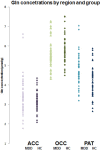Brain glutamate in medication-free depressed patients: a proton MRS study at 7 Tesla
- PMID: 29224573
- PMCID: PMC6088784
- DOI: 10.1017/S0033291717003373
Brain glutamate in medication-free depressed patients: a proton MRS study at 7 Tesla
Abstract
Background: The possible role of glutamate in the pathophysiology and treatment of depression is of intense current interest. Proton magnetic resonance spectroscopy (MRS) enables the detection of glutamate in the living human brain and meta-analyses of previous MRS studies in depressed patients have suggested that glutamate levels are decreased in anterior brain regions. Nevertheless, at conventional magnetic field strengths [1.5-3 Tesla (T)], it is difficult to separate glutamate from its metabolite and precursor, glutamine, with the two often being measured together as Glx. In contrast, MRS at 7 T allows clear spectral resolution of glutamate and glutamine.
Method: We studied 55 un-medicated depressed patients and 50 healthy controls who underwent MRS scanning at 7 T with voxels placed in anterior cingulate cortex, occipital cortex and putamen (PUT). Neurometabolites were calculated using the unsuppressed water signal as a reference.
Results: Compared with controls, depressed patients showed no significant difference in glutamate in any of the three voxels studied; however, glutamine concentrations in the patients were elevated by about 12% in the PUT (p < 0.001).
Conclusions: The increase in glutamine in PUT is of interest in view of the postulated role of the basal ganglia in the neuropsychology of depression and is consistent with elevated activity in the descending cortical glutamatergic innervation to the PUT. The basal ganglia have rarely been the subject of MRS investigations in depressed patients and further MRS studies of these structures in depression are warranted.
Keywords: Basal ganglia; MRS; depression; glutamate; glutamine.
Figures


References
-
- Abdallah CG, Hannestad J, Mason GF, Holmes SE, DellaGioia N, Sanacora G, Jiang L, Matuskey D, Satodiya R, Gasparini F and Lin X (2017) Metabotropic glutamate receptor 5 and glutamate involvement in major depressive disorder: a multimodal imaging strategy. Biological Psychiatry: Cognitive Neuroscience and Neuroimaging 2, 449–456. - PMC - PubMed
-
- Arnone D, Mumuni AN, Jauhar S, Condon B and Cavanagh J (2015) Indirect evidence of selective glial involvement in glutamate-based mechanisms of mood regulation in depression: meta-analysis of absolute prefrontal neuro-metabolic concentrations. European Neuropsychopharmacology 25, 1109–1117. - PubMed
-
- Ashburner J and Friston KJ (2005) Unified segmentation. NeuroImage 26, 839–851. - PubMed
-
- Beck AT, Ward CH, Mendelson M, Mock J and Erbaugh J (1961) An inventory for measuring depression. Archives of General Psychiatry 4, 561–571. - PubMed
-
- Bond DJ and Lim KO (2014) 13C magnetic resonance spectroscopy and glutamate metabolism in mood disorders: current challenges, potential opportunities. American Journal of Psychiatry 171, 1240–1242. - PubMed
Publication types
MeSH terms
Substances
Grants and funding
LinkOut - more resources
Full Text Sources
Other Literature Sources

